What Is Tea Tree Oil?
Tea tree oil is a natural essential oil extracted from the leaves of the Melaleuca alternifolia tree, which is native to Australia. For centuries, Aboriginal communities used the crushed leaves to treat wounds and skin conditions, and today the oil is distilled into a concentrated form that’s widely used in both natural remedies and personal care products.
The power of tea tree oil comes from its unique chemical compounds, especially terpinen-4-ol, which gives the oil its strong antibacterial and antifungal properties. Other active components like γ-terpinene and α-terpinene contribute antioxidant and anti-inflammatory effects. Together, these compounds make tea tree oil a versatile natural agent for cleansing, soothing, and protecting.
You’ll most often find tea tree oil sold as 100% pure essential oil in small glass bottles, but it’s also available in creams, gels, shampoos, and pre-diluted roll-ons. These product variations make it easy to choose the right format for your needs—whether you’re looking to target blemishes, support scalp health, or make a DIY natural cleaner.
Benefits of Tea Tree Oil
Tea tree oil is prized for its wide range of natural healing and cleansing properties. Thanks to its antimicrobial and anti-inflammatory compounds, it supports skin, hair, and overall wellness in multiple ways.
Skin Benefits
One of the best-known benefits of tea tree oil is its ability to support clear, healthy skin. Its antibacterial and anti-inflammatory properties help reduce acne breakouts, soothe irritation from minor cuts or scrapes, and even speed up the natural healing process. Many skincare products now include tea tree essential oil for its ability to calm redness and fight blemishes naturally.
Scalp & Hair Benefits
When added to shampoos or scalp treatments, tea tree oil can help relieve dandruff, itchiness, and irritation. Its antifungal activity helps reduce the growth of flakes, while its soothing qualities calm the scalp. Tea tree oil has also been studied for its effectiveness against lice, making it a popular natural remedy for scalp care.
Respiratory Support
Tea tree oil’s immune-supportive and decongestant qualities make it a useful ally when dealing with coughs, colds, or congestion. Diffusing the oil in a room can help purify the air, ease breathing, and provide a refreshing boost during seasonal illnesses.
Cleansing Properties
Beyond skin and hair, tea tree oil is also valued as a natural cleaner. Its broad-spectrum antibacterial, antifungal, and antiviral properties make it effective in everything from surface sprays to homemade deodorants. This makes tea tree essential oil a safer, plant-based alternative to harsh chemical disinfectants in the home.
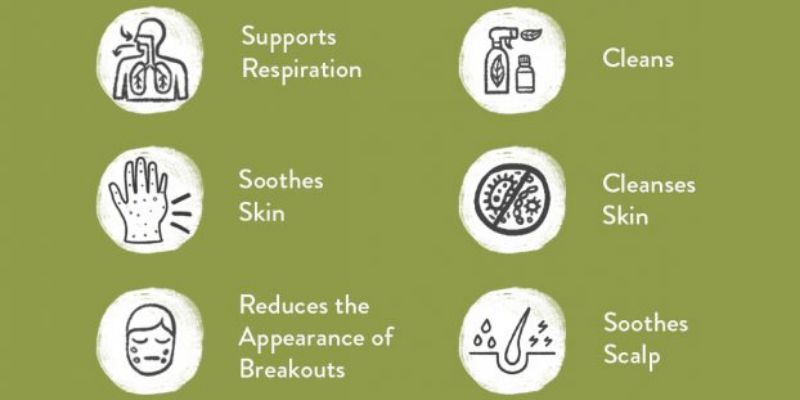
Top Uses of Tea Tree Oil
With its antimicrobial and soothing properties, tea tree oil has become a go-to essential oil for skin care, hair health, natural cleaning, and everyday first aid. Below are some of the most common and effective tea tree oil uses you can try at home.
For Skin & Beauty
Tea tree oil is best known for its role in skincare.
- Acne spot treatment – When diluted with a carrier oil (such as jojoba or coconut oil), it can be applied directly to blemishes to reduce redness and swelling.
- Natural toner / blackhead control – Add a few drops of tea tree essential oil to witch hazel or aloe vera gel for a gentle toner that helps control excess oil and unclog pores.
For Hair & Scalp
Regular use of tea tree oil can help maintain a healthier scalp.
- Anti-dandruff shampoo additive – Mixing 2–3 drops into your shampoo may reduce flakes and scalp irritation.
- Scalp soothing oil blend – Combine with a carrier oil and massage into the scalp to ease itchiness and promote comfort.
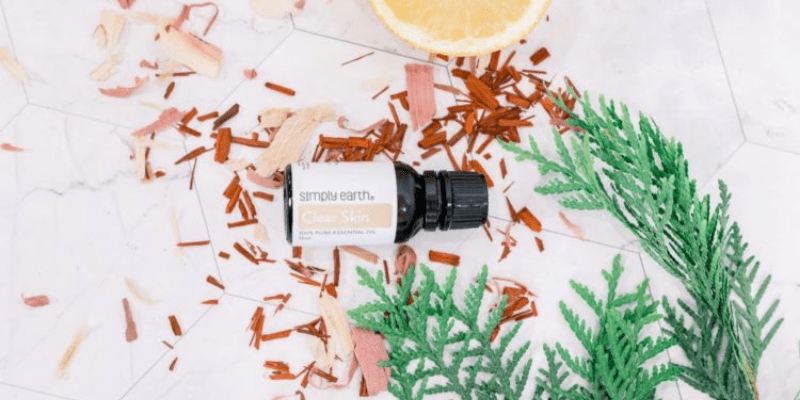
For Home & Cleaning
Because of its strong antibacterial and antifungal action, tea tree oil is a natural alternative to chemical cleaners.
- Surface cleaner – Mix tea tree oil with vinegar and water for an all-purpose spray.
- Mold & mildew spray – Use diluted tea tree oil to target problem areas in the bathroom or kitchen.
- Natural deodorizer – Add a few drops to a diffuser or cleaning solution to neutralize odors.
For Wellness & First Aid
Tea tree oil can also be part of your natural first-aid toolkit.
- Insect bites relief – A diluted application can reduce itchiness and swelling.
- Minor cuts & scrapes – Apply carefully in diluted form to help cleanse and protect small wounds from infection.
How to Use Tea Tree Oil Safely
Tea tree oil is powerful, which means proper use is essential for safety and effectiveness. Here’s what you need to know about how to use tea tree oil in your daily routine.
Dilution Guidelines by Application
Tea tree essential oil should never be applied undiluted to the skin. Always mix with a carrier oil (like coconut, jojoba, or almond oil) or with a base product (like shampoo or lotion).
- Face (acne, blemishes): 1% dilution (about 1 drop per teaspoon of carrier oil)
- Body / larger areas: 2–3% dilution (2–3 drops per teaspoon of carrier oil)
- Hair & scalp: 2% dilution (add 3–5 drops per tablespoon of shampoo or conditioner)
- Household cleaning: 5–10% dilution (15–30 drops per 2 ounces of water/vinegar solution)
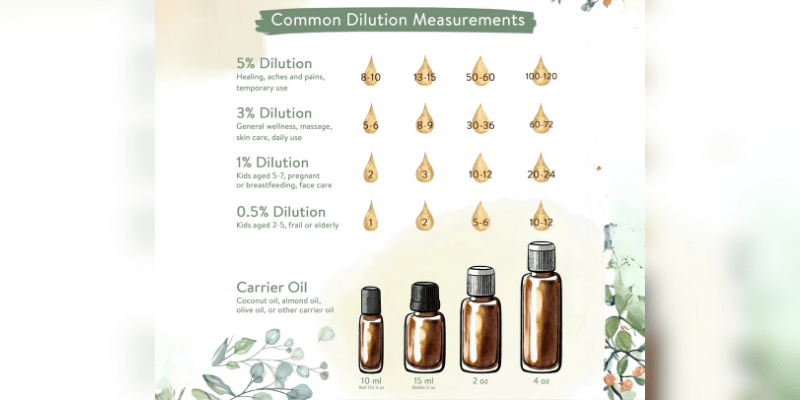
Patch Test Instructions
Before using tea tree oil on a larger area, always do a patch test:
- Dilute 1 drop of tea tree oil in a carrier oil.
- Apply to a small area on your inner arm.
- Wait 24 hours to check for redness, itching, or irritation.
Do’s and Don’ts
✅ Store tea tree oil in a dark glass bottle, away from heat and sunlight, to prevent oxidation.
✅ Use only diluted oil on the skin.
❌ Never ingest tea tree oil — it is toxic when swallowed.
❌ Avoid contact with eyes, inner ears, and mucous membranes.
❌ Don’t apply to broken skin without proper dilution.
Who Should Use Caution
- Children: Avoid use on infants and young children; always consult a pediatrician before use.
- Pregnant & breastfeeding women: Use only under medical guidance.
- Pets: Cats and dogs may react negatively to tea tree oil. Avoid applying it directly to pets, and monitor their behavior if diffused in the home.
By following these safety tips, you can enjoy the many tea tree oil uses while avoiding unwanted side effects.
Tea Tree Oil in Aromatherapy & Diffusers
When it comes to aromatherapy, tea tree oil offers more than just a fresh, herbal scent. Diffusing this essential oil can support your home environment and your overall well-being.
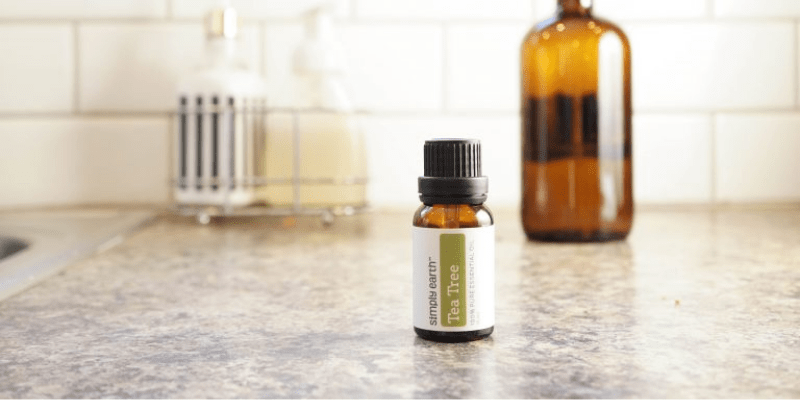
Benefits of Diffusing Tea Tree Oil
- Purifies the air – Its natural antibacterial and antifungal properties make it excellent for cleansing the atmosphere and reducing airborne microbes.
- Eases congestion – Inhaling tea tree oil vapor may help open the airways, making it useful during seasonal colds or allergies.
- Creates a calming environment – While refreshing, the oil’s clean, earthy aroma can also promote mental clarity and relaxation.
Simple Diffuser Blends to Try
- Fresh & Clean: Tea Tree + Lemon + Eucalyptus
- Relax & Refresh: Tea Tree + Lavender + Bergamot
- Breathe Easy: Tea Tree + Peppermint + Eucalyptus
- Balanced Calm: Tea Tree + Lavender + Lemon
Just add 3–5 drops of tea tree oil to your diffuser, paired with 2–3 drops of complementary oils, and enjoy the natural benefits of tea tree oil aromatherapy.
Best Oils to Blend With Tea Tree
Tea tree essential oil has a fresh, herbal aroma with a slightly medicinal note, making it versatile for blending with other oils. Knowing which oils pair well enhances both the scent profile and the therapeutic effects.
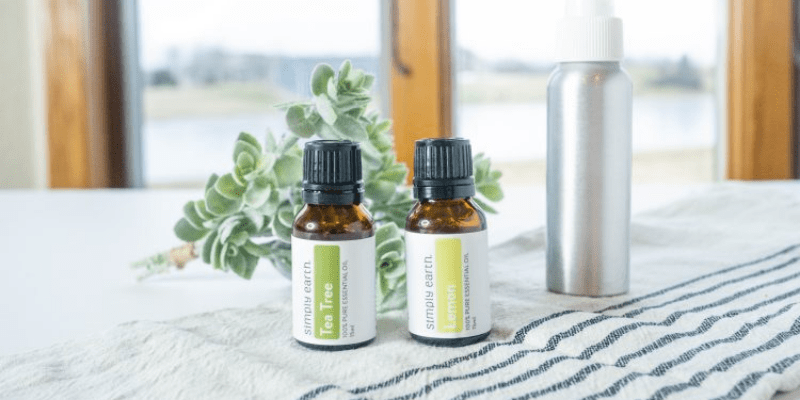
Citrus Oils
Bright citrus oils like lemon and grapefruit balance tea tree’s sharpness with a refreshing, uplifting aroma. These blends are especially great for surface cleaners, room sprays, or energizing diffuser recipes.
Herbal Oils
Classic herbal oils such as lavender, rosemary, and eucalyptus complement tea tree’s cleansing qualities. Lavender adds calm, rosemary sharpens focus, and eucalyptus boosts respiratory support—perfect for diffuser blends or DIY skin care.
Spicy Oils
Warming oils like nutmeg and marjoram pair nicely with tea tree, creating grounding blends that feel both cozy and purifying. These combinations work well in massage oils or stress-relief roll-ons.
Lavender + Tea Tree for Skin
One of the most popular pairings is lavender and tea tree oil. Together, they combine antibacterial and soothing properties, making them ideal for skincare. A diluted mix of these two oils can calm redness, support acne-prone skin, and promote faster healing of minor blemishes.
By experimenting with these blends, you can unlock even more benefits from tea tree oil while creating unique scents and targeted remedies.
Simple Tea Tree Oil Recipes
If you’re looking for easy ways to incorporate tea tree oil into your daily routine, try these simple, effective recipes. Each one makes use of tea tree’s natural cleansing and soothing properties while keeping ingredients safe and accessible.
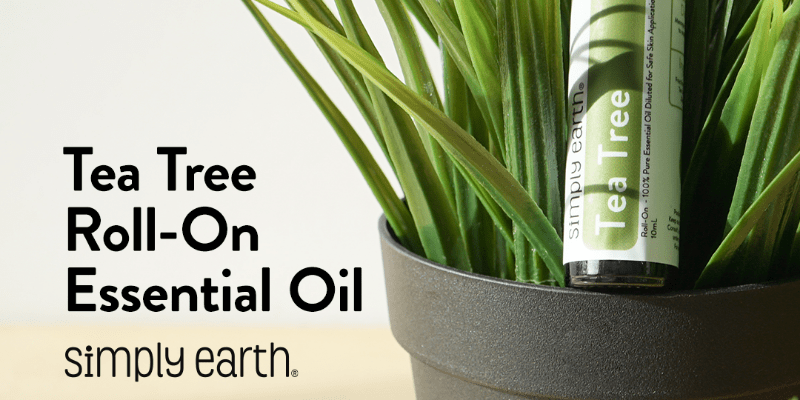
Skincare Recipe – DIY Acne Toner
- ½ cup witch hazel
- 5 drops tea tree oil
- 3 drops lavender oil (optional for added calming)
- Store in a glass spray bottle. Shake before use and apply with a cotton pad to clean skin.
Roll-On Recipe – For Blemishes or Stress Relief
- 10 ml roller bottle
- Carrier oil (such as jojoba or fractionated coconut oil)
- 2 drops tea tree oil
- 2 drops lavender or peppermint oil
- Fill with carrier oil, shake gently, and apply to blemishes or temples as needed.
Cleaning Spray – Tea Tree + Lemon + Vinegar
- 1 cup distilled water
- 1 cup white vinegar
- 10 drops tea tree oil
- 10 drops lemon oil
- Combine in a spray bottle for an all-purpose cleaner. Use on counters, sinks, and other surfaces.
Diffuser Blend – Clean & Crisp Home Blend
- 3 drops tea tree oil
- 2 drops lemon oil
- 2 drops eucalyptus oil
- Add to your diffuser with the recommended water level for a fresh, purifying atmosphere.
These quick tea tree oil recipes are versatile, safe, and beginner-friendly—perfect for anyone who wants to replace harsh chemicals with natural alternatives.
Choosing Quality Tea Tree Oil
Not all tea tree oils are created equal. To get the maximum benefits and ensure safety, it’s important to choose a high-quality product. Here’s what to look for when buying and storing tea tree oil.
What to Look For
- GC/MS testing: Reputable brands provide a Gas Chromatography/Mass Spectrometry (GC/MS) report, which confirms purity and shows the oil’s chemical composition.
- Proper packaging: Pure tea tree oil should be sold in dark amber or cobalt glass bottles to protect it from light damage.
- Key compound levels: Look for a product with terpinen-4-ol content above 30% (the main antimicrobial component) and 1,8-cineole content below 15% to minimize skin irritation.
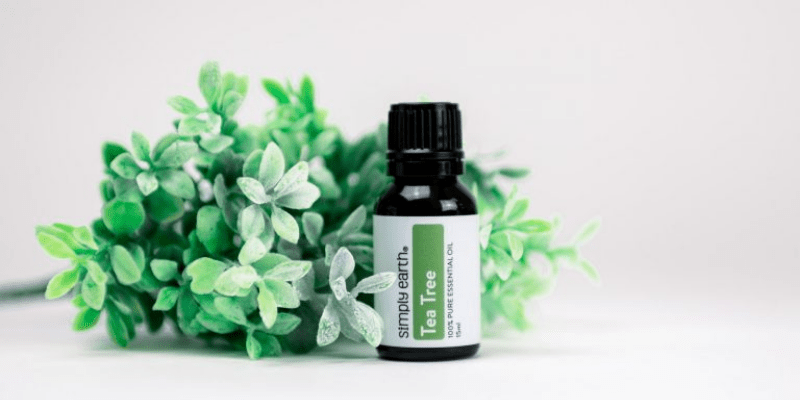
Shelf Life & Storage Tips
- Tea tree oil typically lasts 1–2 years when stored correctly.
- Keep bottles in a cool, dark place, away from direct sunlight and heat.
- Always close the cap tightly to prevent oxidation.
Signs of Oxidation or Adulteration
- A change in smell (from fresh and medicinal to rancid or sour) is a sign the oil has degraded.
- Cloudy appearance or unusual thickness may mean the oil is old or contaminated.
- Extremely low prices can indicate adulteration with synthetic fillers—always buy from trusted brands.
By choosing quality tea tree oil and storing it properly, you’ll get the most from its powerful natural properties while keeping your skin and home safe.
Things to Remember (Safety & Precautions)
While tea tree oil is a powerful natural remedy, it’s important to use it with care. Misuse can lead to unwanted tea tree oil side effects, so always follow these guidelines.
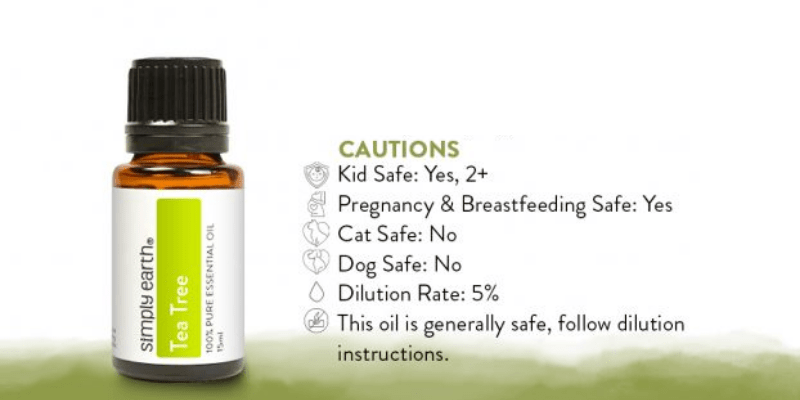
Skin Sensitivity and Irritation Risks
Tea tree oil is strong and may cause redness, dryness, or rashes if used undiluted. Always dilute with a carrier oil and do a patch test before applying it to larger areas of skin. People with eczema or very sensitive skin should use extra caution.
Why Ingestion Is Unsafe
Despite its many topical benefits, you should never drink tea tree oil. Ingesting even small amounts can cause dizziness, stomach upset, confusion, or serious toxicity. Use it only externally or in aromatherapy, unless directed otherwise by a qualified medical professional.
Interactions With Medications
Tea tree oil may interact with certain topical treatments or skincare products, especially those that are already drying (like benzoyl peroxide or retinoids). Combining them can increase irritation. If you’re on prescription medications or under medical care, consult your doctor before adding tea tree oil to your routine.
When to See a Doctor Instead
Tea tree oil can help with mild issues like blemishes, dandruff, or minor cuts, but it’s not a substitute for professional care. If you have severe acne, fungal infections that don’t improve, or respiratory issues that worsen, seek medical advice.
By using tea tree oil responsibly, you can enjoy its natural benefits while minimizing risks.
FAQs on Tea Tree Oil
What is tea tree oil good for?
Tea tree oil is good for a variety of uses, from skincare and scalp care to natural home cleaning. It can help reduce acne, soothe irritation, relieve dandruff, and freshen indoor air when diffused. Its antimicrobial properties also make it effective in surface cleaners and first-aid applications.
What does tea tree oil do?
Tea tree oil works as a natural antibacterial, antifungal, and anti-inflammatory agent. It helps protect skin from infection, reduces redness and swelling, and supports respiratory comfort when inhaled through aromatherapy.
Can you drink tea tree oil?
No—you should never drink tea tree oil. Ingesting it is unsafe and can cause serious side effects such as dizziness, nausea, or confusion. Tea tree oil is only safe for external use and aromatherapy when properly diluted.
What does tea tree oil smell like?
Tea tree oil has a fresh, herbal, and slightly medicinal scent with woody and earthy undertones. Some describe it as sharp and invigorating, which is why it blends well with softer oils like lavender or citrus oils like lemon and grapefruit.
What are the benefits of tea tree oil in a diffuser?
When diffused, tea tree oil helps purify the air, ease congestion, and promote mental clarity. Many people use it during seasonal colds, or simply to create a clean, refreshing environment at home. Pairing it with lavender, eucalyptus, or lemon enhances both its aroma and benefits.
Final Thoughts
Tea tree oil is a powerful and versatile essential oil with proven benefits for skin, hair, home cleaning, and overall wellness. From soothing acne and dandruff to purifying the air and freshening surfaces, its antimicrobial properties make it a valuable addition to any natural care routine.
That said, it’s important to remember that tea tree oil must be used safely. Always dilute before applying to skin, never ingest it, and take extra precautions with children, pets, and sensitive individuals.
While tea tree oil can complement healthy living and provide relief for mild issues, it is a natural remedy—not a medical cure. For serious or persistent conditions, professional medical guidance should always come first.

